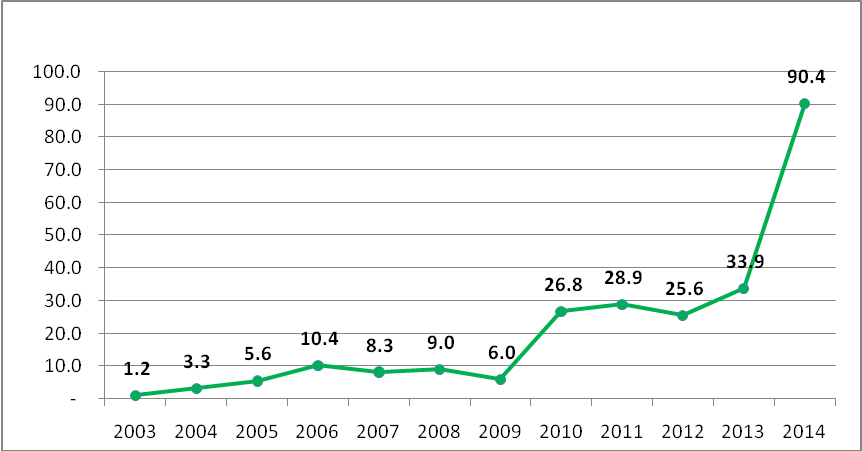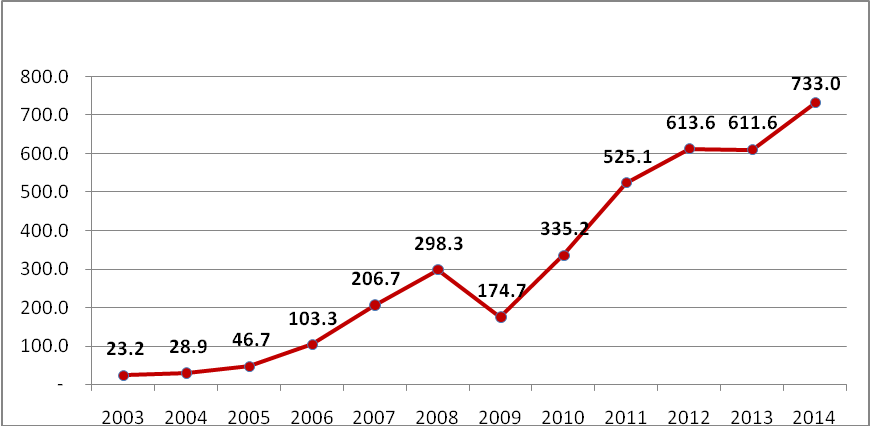On 13 September 2015, the Minister of Energy of Georgia, Kakha Kaladze, stated that Georgia has a deficit in electricity which grows with each year. According to the Minister’s assessment, the growth of the deficit is due to increased consumption which is caused by the growth of the economy.
FactCheck analysed the trend of growth in the deficit of electricity and looked into its reasons.
The deficit of electricity referred to by the Minister implies the difference between the electricity generated in the country and the overall consumption of electricity. About 80% of local electricity production in Georgia comes from hydro power plants (HPP). Because of this fact, therefore, Georgia’s local production has a seasonal character. The production rate is at its highest from April to August when the level of river water rises. Furthermore, the country’s thermal power plants virtually stop operating from March to August which means that local production depends solely upon HPPs. The average monthly domestic production in the April to August period is 900 million kWh which is sufficient to cover domestic consumption and which renders the import of electricity unnecessary. In addition, the consumption of electricity falls in the summer. Georgia’s reliance upon imported electricity grows from September to March with imports characterised as especially high from November to January. This is the period when domestic consumption increases whilst the production of the HPPs decreases due to the low levels of river water. Imports constituted about 15% of the domestic consumption from November 2014 to January 2015. The share of imports in annual consumption varies from 6% to 7%.
Table 1: Electricity Supply to Georgia (Million kWh)
|
2006 |
2007 |
2008 |
2009 |
2010 |
2011 |
2012 |
2013 |
2014 |
2015 (8 months) |
| Production |
2,757 |
8,346 |
8,451 |
8,408 |
10,057 |
10,105 |
9,695 |
10,059 |
10,370 |
7,481 |
| Thermal Power Plants |
945 |
1,515 |
1,282 |
991 |
683 |
2,212 |
2,472 |
1,788 |
2,036 |
1,229 |
| Share in Supply |
34.4% |
17.6% |
14.4% |
11.6% |
6.7% |
21.3% |
24.5% |
17.3% |
18.5% |
15.6% |
| HPPs |
1,813 |
6,831 |
7,169 |
7,417 |
9,375 |
7,892 |
7,223 |
8,271 |
8,334 |
6,252 |
| Share in Supply |
66.0% |
79.4% |
80.3% |
86.9% |
92.4% |
76.0% |
71.6% |
80.0% |
75.7% |
79% |
| Imports |
60 |
433 |
649 |
255 |
222 |
471 |
615 |
484 |
852 |
389 |
| Share in Supply |
2.2% |
5.0% |
7.3% |
3.0% |
2.2% |
4.5% |
6.1% |
4.7% |
7.7% |
5.0% |
| Overall Resources |
2,817 |
8,779 |
9,100 |
8,663 |
10,280 |
10,575 |
10,309 |
10,543 |
11,222 |
7,870 |
| Losses |
72 |
176 |
169 |
130 |
139 |
192 |
226 |
198 |
216 |
154 |
| Supply to the Network |
2,745 |
8,603 |
8,930 |
8,533 |
10,141 |
10,383 |
10,087 |
10,345 |
11,006 |
7,716 |
Source: Electricity Market Operator
Traditionally, Georgia exports electricity from April to August. Georgia exported a total of 562 million kWh of electricity from April to August 2015 and 498 kWh in the same period of 2014.
Table 2: Data of Exports and Imports of Electricity (Million kWh)
|
2011 |
2012 |
2013 |
2014 |
2015 (8 months) |
| Imports |
-471 |
-615 |
-484 |
-793 |
-389.4 |
| Exports |
931 |
528 |
450 |
545 |
590.3 |
| Balance |
460 |
-86 |
-34 |
-248 |
201 |
The Minister of Energy of Georgia is quite correct when talking about the annual growth of the electricity deficit (which is the imported amount of electricity). Chart 1 shows that the electricity deficit has had a trend of growth for the past several years and that an especially high level of growth was recorded in 2014.
Chart 1: Electricity Imports (Deficit) to Georgia

Georgia imports electricity mainly from Russia and Azerbaijan. Hence, the import dependency upon these countries grows as well. Electricity imports from Russia increased by 32% in 2014.
Table 3: Imports of Electricity from Russia and Azerbaijan (Million kWh)
|
2011 |
2012 |
2013 |
2014 |
2015 (8 months) |
| Russia |
448 |
517 |
461 |
607 |
265 |
| Azerbaijan |
23 |
98 |
24 |
184 |
102 |
Source: Electricity Market Operator
The main reason for the growth of imports is increased consumption. The growth of consumption is higher than that of domestic production and, therefore, has to be balanced by imports. The domestic consumption grew by 919 million kWh from 2013 to 2014 whilst local production grew by 675 million kWh. The growth of consumption, apart from the economic growth of the country, is also determined by the changes in electricity tariffs. The tariff increased significantly in 2006 from an average of 10
tetri to 15
tetri. Due to the aforementioned changes, the supply of electricity increased whilst the population started to use electricity more economically. As a result, Georgia reached a 24-hour electricity supply. The amount of electricity generated in Georgia increased by 300% in 2007 as compared to 2006 whilst the production of HPPs grew by 377%.
The decrease in the electricity tariff was one of the pre-election promises of the Georgian Dream coalition. At the end of 2012, the Georgian National Energy and Water Supply Regulatory Commission and the energy companies were tasked with "finding" the resources to decrease the electricity tariff. The tariff did indeed drop from January 2013. The electricity tariff for consumption below 300 kWh went down by 3.54
tetri and by 2.7
tetri for consumption of more than 300 kWh. The tariff remained the same for legal entities. Tariffs decreased in the main at the expense of a drop in profits for energy companies in parallel with the drop in their investment obligations.
Foreign direct investment in the energy sector decreased by 45% in 2014 as compared to 2012. The amount of investments dropped even further in the first half of 2015 and amounted to USD 20 million which is 65% less than in the same period of the previous year and 78% less than in the first quarter of 2012.
Chart 2: Foreign Direct Investments Attracted in the Energy Sector, USD million
 Source: National Statistics Office of Georgia
Conclusion
Source: National Statistics Office of Georgia
Conclusion
The negative balance between the production and consumption of electricity (deficit) in Georgia is growing. As a result, the share of imported energy and the country’s dependency upon Russian and Azerbaijani electricity is growing. However, so far the annual share of imported electricity is 6%-7% and is not "huge" as stated by the Minister. It reaches its maximum of -15% in January. The direct reason for the growth of imports is increased domestic consumption. However, it should be pointed out that in the case of a higher domestic production growth rate, the import dependency would not have grown.
FactCheck concludes that Kakha Kaladze’s statement: "We have a huge deficit in electricity which is growing every year," is
MOSTLY TRUE.
 Georgia imports electricity mainly from Russia and Azerbaijan. Hence, the import dependency upon these countries grows as well. Electricity imports from Russia increased by 32% in 2014.
Table 3: Imports of Electricity from Russia and Azerbaijan (Million kWh)
Georgia imports electricity mainly from Russia and Azerbaijan. Hence, the import dependency upon these countries grows as well. Electricity imports from Russia increased by 32% in 2014.
Table 3: Imports of Electricity from Russia and Azerbaijan (Million kWh)
 Source: National Statistics Office of Georgia
Conclusion
The negative balance between the production and consumption of electricity (deficit) in Georgia is growing. As a result, the share of imported energy and the country’s dependency upon Russian and Azerbaijani electricity is growing. However, so far the annual share of imported electricity is 6%-7% and is not "huge" as stated by the Minister. It reaches its maximum of -15% in January. The direct reason for the growth of imports is increased domestic consumption. However, it should be pointed out that in the case of a higher domestic production growth rate, the import dependency would not have grown.
FactCheck concludes that Kakha Kaladze’s statement: "We have a huge deficit in electricity which is growing every year," is MOSTLY TRUE.
Source: National Statistics Office of Georgia
Conclusion
The negative balance between the production and consumption of electricity (deficit) in Georgia is growing. As a result, the share of imported energy and the country’s dependency upon Russian and Azerbaijani electricity is growing. However, so far the annual share of imported electricity is 6%-7% and is not "huge" as stated by the Minister. It reaches its maximum of -15% in January. The direct reason for the growth of imports is increased domestic consumption. However, it should be pointed out that in the case of a higher domestic production growth rate, the import dependency would not have grown.
FactCheck concludes that Kakha Kaladze’s statement: "We have a huge deficit in electricity which is growing every year," is MOSTLY TRUE.
 Georgia imports electricity mainly from Russia and Azerbaijan. Hence, the import dependency upon these countries grows as well. Electricity imports from Russia increased by 32% in 2014.
Table 3: Imports of Electricity from Russia and Azerbaijan (Million kWh)
Georgia imports electricity mainly from Russia and Azerbaijan. Hence, the import dependency upon these countries grows as well. Electricity imports from Russia increased by 32% in 2014.
Table 3: Imports of Electricity from Russia and Azerbaijan (Million kWh)
 Source: National Statistics Office of Georgia
Conclusion
The negative balance between the production and consumption of electricity (deficit) in Georgia is growing. As a result, the share of imported energy and the country’s dependency upon Russian and Azerbaijani electricity is growing. However, so far the annual share of imported electricity is 6%-7% and is not "huge" as stated by the Minister. It reaches its maximum of -15% in January. The direct reason for the growth of imports is increased domestic consumption. However, it should be pointed out that in the case of a higher domestic production growth rate, the import dependency would not have grown.
FactCheck concludes that Kakha Kaladze’s statement: "We have a huge deficit in electricity which is growing every year," is MOSTLY TRUE.
Source: National Statistics Office of Georgia
Conclusion
The negative balance between the production and consumption of electricity (deficit) in Georgia is growing. As a result, the share of imported energy and the country’s dependency upon Russian and Azerbaijani electricity is growing. However, so far the annual share of imported electricity is 6%-7% and is not "huge" as stated by the Minister. It reaches its maximum of -15% in January. The direct reason for the growth of imports is increased domestic consumption. However, it should be pointed out that in the case of a higher domestic production growth rate, the import dependency would not have grown.
FactCheck concludes that Kakha Kaladze’s statement: "We have a huge deficit in electricity which is growing every year," is MOSTLY TRUE.








